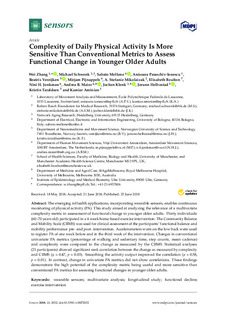| dc.contributor.author | Zhang, Wei | |
| dc.contributor.author | Schwenk, Michael | |
| dc.contributor.author | Mellone, Sabato | |
| dc.contributor.author | Paraschiv-Ionescu, Anisoara | |
| dc.contributor.author | Vereijken, Beatrix | |
| dc.contributor.author | Pijnappels, Mirjam | |
| dc.contributor.author | Mikolaizak, A. Stefanie | |
| dc.contributor.author | Boulton, Elisabeth | |
| dc.contributor.author | Jonkman, Nini H. | |
| dc.contributor.author | Maier, Andrea B. | |
| dc.contributor.author | Klenk, Jochen | |
| dc.contributor.author | Helbostad, Jorunn L. | |
| dc.contributor.author | Taraldsen, Kristin | |
| dc.contributor.author | Aminian, Kamiar | |
| dc.date.accessioned | 2019-09-19T08:11:17Z | |
| dc.date.available | 2019-09-19T08:11:17Z | |
| dc.date.created | 2019-01-20T13:33:17Z | |
| dc.date.issued | 2018 | |
| dc.identifier.citation | Sensors. 2018, 18 (7), 1-12. | nb_NO |
| dc.identifier.issn | 1424-8220 | |
| dc.identifier.uri | http://hdl.handle.net/11250/2617573 | |
| dc.description.abstract | The emerging mHealth applications, incorporating wearable sensors, enables continuous monitoring of physical activity (PA). This study aimed at analyzing the relevance of a multivariate complexity metric in assessment of functional change in younger older adults. Thirty individuals (60–70 years old) participated in a 4-week home-based exercise intervention. The Community Balance and Mobility Scale (CBMS) was used for clinical assessment of the participants’ functional balance and mobility performance pre- and post- intervention. Accelerometers worn on the low back were used to register PA of one week before and in the third week of the intervention. Changes in conventional univariate PA metrics (percentage of walking and sedentary time, step counts, mean cadence) and complexity were compared to the change as measured by the CBMS. Statistical analyses (21 participants) showed significant rank correlation between the change as measured by complexity and CBMS (ρ = 0.47, p = 0.03). Smoothing the activity output improved the correlation (ρ = 0.58, p = 0.01). In contrast, change in univariate PA metrics did not show correlations. These findings demonstrate the high potential of the complexity metric being useful and more sensitive than conventional PA metrics for assessing functional changes in younger older adults. | nb_NO |
| dc.language.iso | eng | nb_NO |
| dc.publisher | MDPI | nb_NO |
| dc.rights | Navngivelse 4.0 Internasjonal | * |
| dc.rights.uri | http://creativecommons.org/licenses/by/4.0/deed.no | * |
| dc.title | Complexity of daily physical activity is more sensitive than conventional metrics to assess functional change in younger older adults | nb_NO |
| dc.type | Journal article | nb_NO |
| dc.type | Peer reviewed | nb_NO |
| dc.description.version | publishedVersion | nb_NO |
| dc.source.pagenumber | 1-12 | nb_NO |
| dc.source.volume | 18 | nb_NO |
| dc.source.journal | Sensors | nb_NO |
| dc.source.issue | 7 | nb_NO |
| dc.identifier.doi | 10.3390/s18072032 | |
| dc.identifier.cristin | 1661182 | |
| dc.description.localcode | This is an open access article distributed under the Creative Commons Attribution License which permits unrestricted use, distribution, and reproduction in any medium, provided the original work is properly cited | nb_NO |
| cristin.unitcode | 194,65,30,0 | |
| cristin.unitname | Institutt for nevromedisin og bevegelsesvitenskap | |
| cristin.ispublished | true | |
| cristin.fulltext | original | |
| cristin.qualitycode | 1 | |

